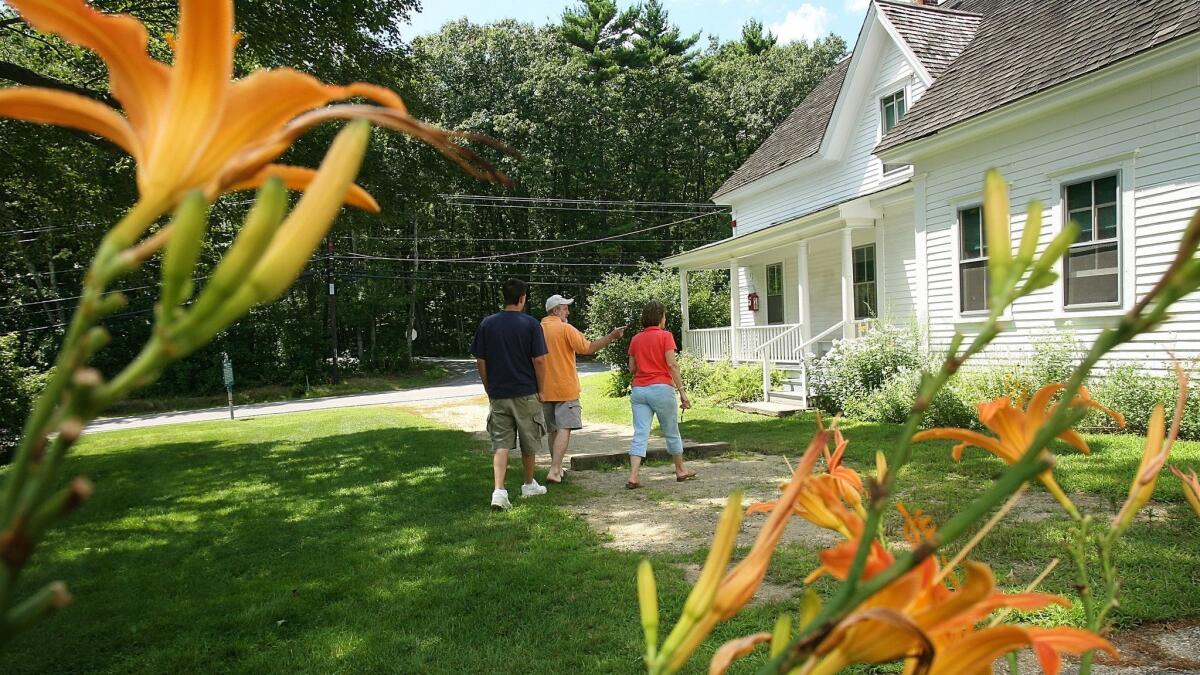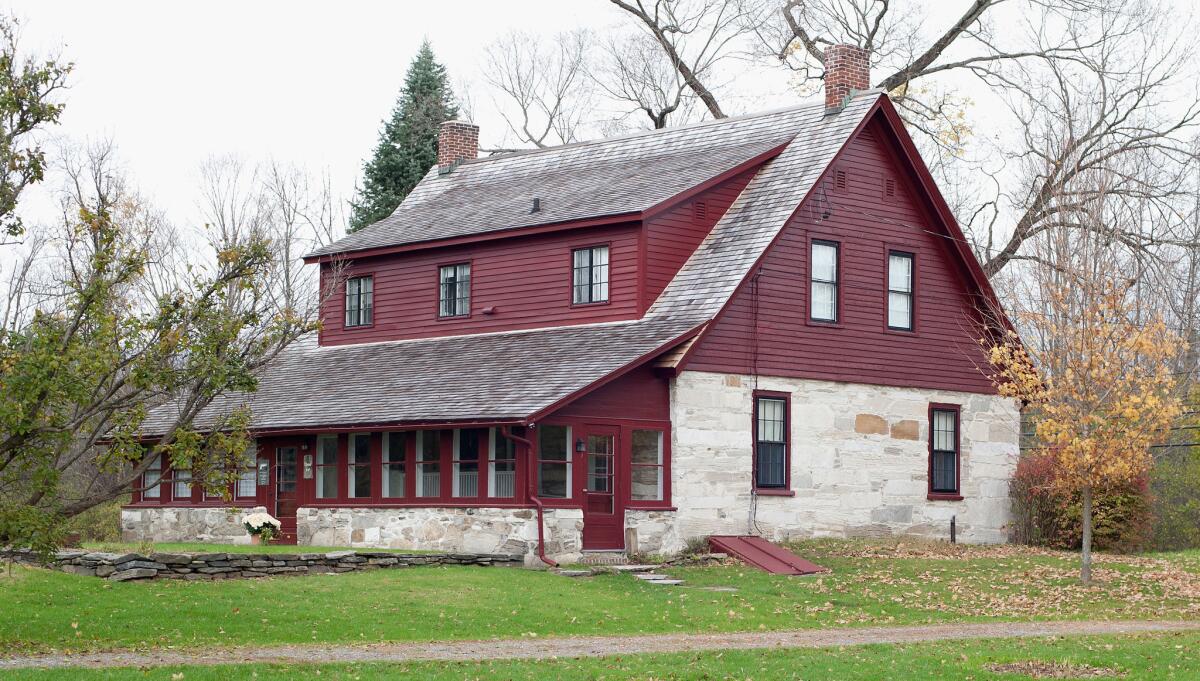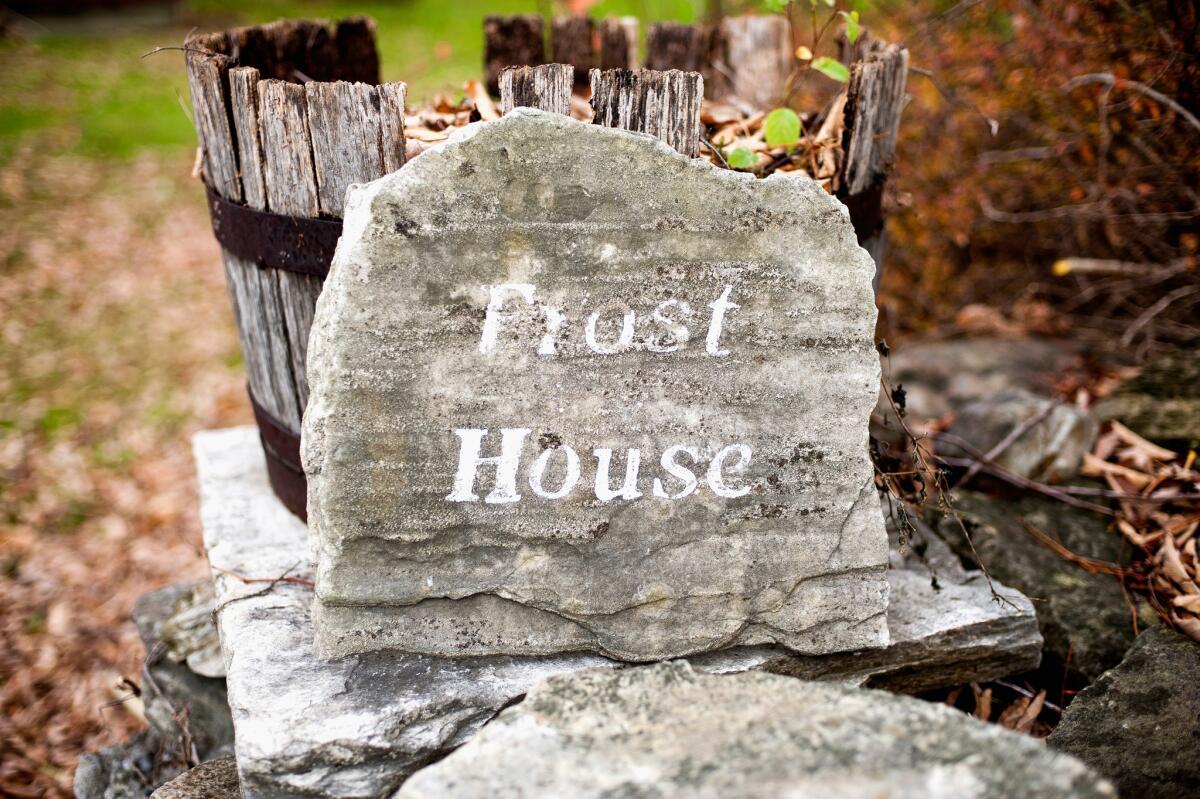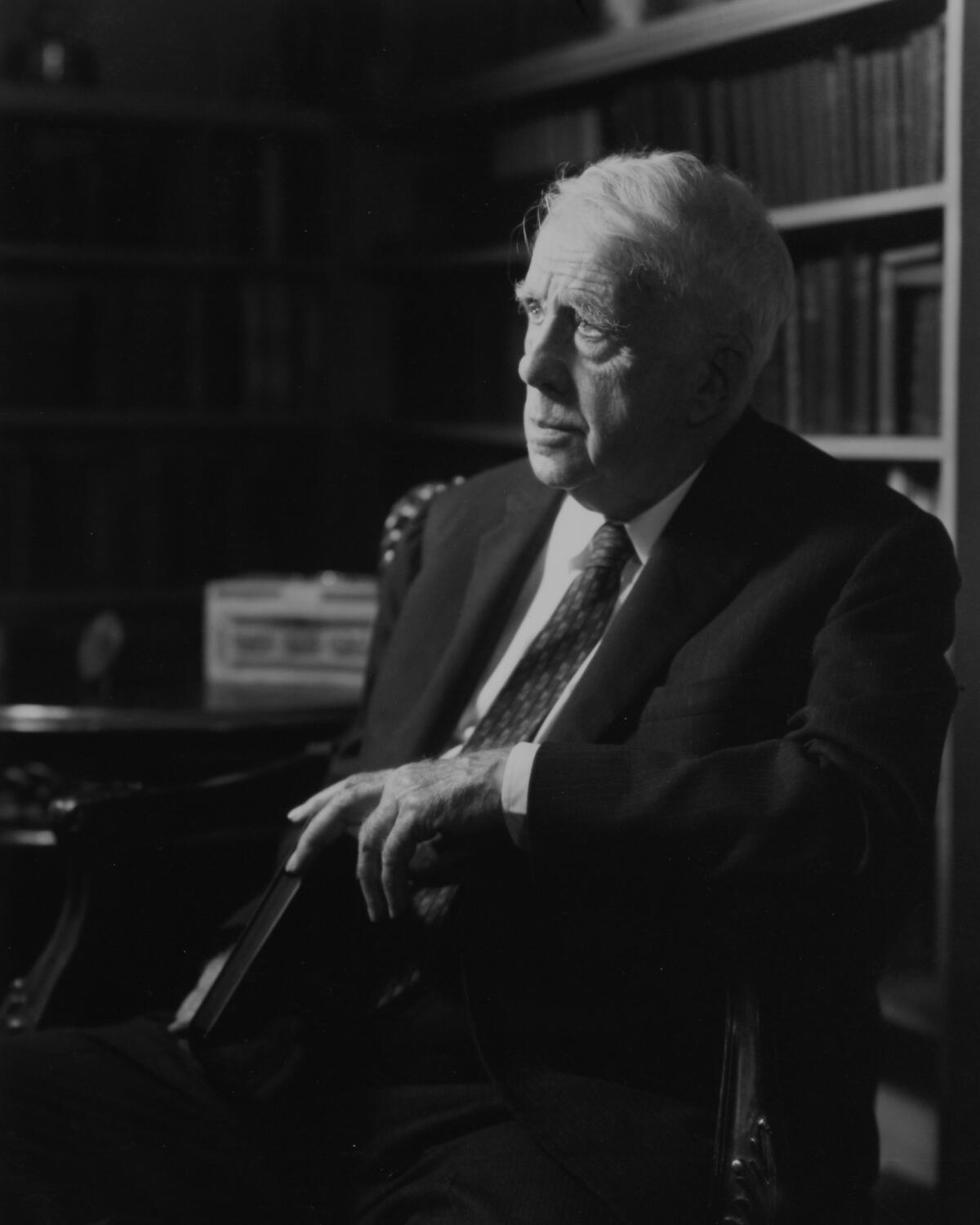The road taken by Robert Frost through New England
- Share via
As I exit the highway, nearing the cabin on the lake in New Hampshire where I’ll be staying for the summer to write, the first thing I see on the side of the road is a dilapidated, old barn — roof caving in, walls crumbling. “Something there is that doesn’t love a wall,” I whisper. The famous first line of Robert Frost’s iconic poem “Mending Wall.” My dog perks up in the passenger seat, tongue lolling out of her mouth, head cocked. She thinks I’m talking to her.
Signs of the quintessential Yankee poet are everywhere in New England, as inescapable as a shadow. Robert Frost and his poems lend their names to trails, roads, houses, restaurants, inns, schools, libraries, even a mountain.
I read about the “design of darkness” in his poems, after buying yellowed hardbacks from local bookstores; I walk paths with lines of his poetry at intervals on trailmarkers; I visit the houses he lived in, of which there are many in New England; I sift through the archive of his papers at Dartmouth College, panning for flecks of gold; my dog sniffs the statue of Frost at the edge of the woods on the campus, the bronze Frost seated on a rock eternally writing those first words of “Mending Wall,” forever frozen in mad pursuit of poetic expression.

Though the man was born in California, it’s clear that the poet was born in New England. He moved from San Francisco to Massachusetts with his mother and sister at the age of eleven after his father died of tuberculosis. In these dense forests and endless forks in the road, Frost found his voice.
In 1900, Frost, in his mid-20s, in the midst of dealing with the still fresh wound of the untimely death of a child, moved his family from Massachusetts to a farm in Derry, N.H. This property, known today as the Robert Frost Farm, is now a museum.
Though the farm is full of impressive artifacts, the highlight of the home actually lies outside of it: the stone partition, prone to deterioration, that inspired the poem “Mending Wall.”
Like much of Frost’s work, the poem is ambiguous. In it, a man and his neighbor walk along a wall that divides their properties, replacing the stones that have tumbled down. As the first line hints, it is a poem about how nature destroys what man builds, yet it’s also about nature (and particularly human nature) being hardwired to keep building anyway, even with the foreknowledge of inevitable entropy. There’s an ongoing waltz in the poem between binaries of camaraderie and isolation, synthesis and division, creation and destruction, harmony and chaos.
A decade after moving to the farm, Frost gave it up, settling the family across the Atlantic in England where he published, finally, his first two collections of poetry. When they returned to America in 1915, Frost was looking for a farm where he “could live cheap and get Yankier and Yankier.” The family settled on a perfect spot in Franconia, N.H. — now known as The Frost Place.
This is the residence that, in the poem “New Hampshire,” Frost claims he “had to take by force rather than buy.” When Frost first stumbled upon it, he knew he had to have it. The view from the front porch remains persuasive: It looks out on the majestic peak of Mount Lafayette.
Frost told Willis Herbert, who owned the property at the time that he planned to put him off the farm — and he did. He bought the property from Herbert, who moved his family down the road.
Both New Hampshire Frost museums have short nature trails, with signs displaying excerpts of Frost’s poetry. His poetry is in its natural environment amongst leaves and dirt. In the shade of tall trees, it becomes clear that the page was never its proper place.
“New Hampshire” ends with a twist: “At present I am living in Vermont.” At least two more Frost houses exist in that state. One of these, in South Shaftsbury, has become a museum; the second, in Ripton, owned by Middlebury College, is not open to the public.
I didn’t get inside the Ripton home; according to legend, the walls bear Frost’s written record of a summer’s daily temperatures. That mythic list exemplifies Frost’s modus operandi. He was a keen observer, struggling always to understand the many sides of a moment, while still allowing it to pass like sand through fingers.
Reading Frost’s poetry changes your relationship to nature—it gets you to listen, to watch, to experience with patience the tiny tumults of the landscape: the way a butterfly floats on wings, petal-soft; the way a towering pine sways almost imperceptibly, dancing with itself; the way white outcroppings of exposed rock protrude from the unending greenery, as though the land, otherwise fully clothed in grass and shrub and tree, has decided to forgo modesty and show a sliver of pale skin.Near the home in Ripton, the Robert Frost Memorial Drive, the Robert Frost Wayside Area and the Robert Frost Interpretive Trail provide ample opportunity to take in the scenery that inspired the poems. I lunch at the wayside area and walk the trail, which is a larger, more impressive version of the poetry trails at both New Hampshire houses.

In South Shaftsbury, at the Robert Frost Stone House Museum, I meet up with author Megan Mayhew Bergman, who now oversees the property for Bennington College. When the college took over the house museum in 2017, it considered how it could honor Frost and the space while also making them relevant to students and the community.
Bergman explains that she doesn’t want to present a romanticized view of the poet but, rather, to engage with him and his poetry “critically and rigorously.” Frost is a complicated figure who, depending on which biography you read, can come across as god or monster.
After a life seen as the genial farmer-poet persona that he created, Frost died at age 88 in 1963. His reputation changed when his friend, Lawrance Thompson, released his three-volume biography (1966-76), in which Frost comes across as an angry megalomaniac. There have been biographies since which try to overcorrect the darker Thompson portrait, and these can sometimes seem more the canonizations of a saint than of a writer. The truth is somewhere in between.
He is not wholly the “bad bad man” he admits to being in a letter nor the affable farmer-poet folk hero of his self-myths. Frost, like all of us, was a tangled mess of many selves, inconsistent and imperfect. “I began life wanting perfection and determined to have it,” he wrote. “I got so I ceased to expect it and could do without it. Now, I find I actually crave the flaws of human handiwork. I gloat over imperfection.” Only the naive would dare seek perfection in people and poetry.
Bergman hopes for Frost’s house to become an active community space. Frost was connected to the founding of Bennington and the area, so it feels a part of his legacy to continue that tradition by keeping the space contemporary. Although it has owned the property for less than a year, the college has already hosted classes, concerts and art exhibits while keeping the place grounded in the poet and his poetry.
I let my neighbour know beyond the hill; And on a day we meet to walk the line And set the wall between us once again.
— Robert Frost, “Mending Wall”
It was while living here that Frost wrote one of his most famous works, “Stopping by Woods on a Snowy Evening,” so the museum has a room focused on that poem, which includes a facsimile of the sheet on which he scribbled the lines. Bergman points out that you can see in his draft that Frost changed the gender of the horse — “probably for rhythm rather than gender politics,” Bergman concedes, “but it’s still quite interesting.”
Perhaps an even more surprising thing to discover while standing in this room is that Frost wrote that classic winter rhyme on a hot summer morning, not unlike today.
Bennington’s recent open house for the museum included a lecture on Frost and the “rural authentic” by critic Stephen Metcalf. Bergman tells me, “It gave us a chance to openly address the real connection between landscape and poem.” As Frost once wrote, “Locality gives art.”

Metcalf’s lecture also allowed them to discuss “Frost’s self-mythology.” If Bergman and Bennington are looking for ways to keep Frost relevant, self-mythology is a good place to start. Not only is the poet himself an excellent example of self-mythologizing, but his most popular poem, “The Road Not Taken,” is about, among other things, how we all must lie to ourselves and others in order to make ourselves seem heroic, to keep from being overwhelmed by our own regrets, to survive for another day.
It becomes clear in these rooms that there is so much more to Frost than the image of a simple farmer espousing country wisdom in artisanal verse. The pastoral moralism that he was often accused of peddling was actually a clever sleight of hand. Frost is darker than all that, more cognizant of nature’s inconsistency, impenetrability and callousness (and man’s inconsistency, impenetrability and callousness too, which is just a mirror to nature’s).
Poet Joseph Brodsky claimed of Frost, “Nature for this poet is neither friend nor foe, nor is it the backdrop for human drama; it is this poet’s terrifying self-portrait.”

Reading Frost’s poems as mere odes to rural idylls de-fangs them. These are not poems of regional idolatry; these are poems which grapple with the world and man’s place within it. They ascend the heights of universality through their local dwelling, much like the stories of Sherwood Anderson or the novels of William Faulkner.
“Just as we think of Keats as forever young, too often we tend to see Frost as forever old,” Bergman says, paraphrasing critic Dan Chiasson. It suddenly seems strange to me that these two poets who were ever-moving, many-sided, have become one-dimensional, fixed in the public consciousness like the figures upon Keats’ Grecian urn.
Instead, we should remember them as men with a radical openness towards the world. They were imperfect and complicated, of course, but they understood, as Keats wrote, that the poet’s primary charge is as “a thoroughfare for all thoughts.”
Frost’s epitaph on his grave in Old Bennington Cemetery reads: “I had a lover’s quarrel with the world.” Quarrelling, for Frost, was thinking. Letting various positions wrestle with one another, wading into that uncertainty, mystery, doubt, was the true aim of a poem, of a poet, of a person.
On the trail of Robert Frost in New England, somewhere among the lush, green forests and between the walls of these houses — houses which will at some point crumble, no matter the historical importance and national landmark designation — I found what I already knew, what was there between the lines of the poetry: the deceptively simple poetics of soil and stone; the rhythms of babbling brooks and murmuring breezes; and, most important, the dark, deep wooded ambiguity of the world laid bare.
I pick up a rock next to that wall that divided Frost’s property from his neighbor’s in Derry. I hold it in my hands for a moment, savoring the contours of the not-quite-spherical stone, like one savors a line of poetry, letting it linger on the tongue. Then I place it in one of the gaps in the wall. I mend and feel mended somehow. Something there is that doesn’t love a wall — indeed — but something there is that does love a wall too.
Malone is a writer based in Southern California. His work has appeared in Lapham’s Quarterly, Literary Hub, the LA Review of Books and elsewhere.
More to Read
Sign up for our Book Club newsletter
Get the latest news, events and more from the Los Angeles Times Book Club, and help us get L.A. reading and talking.
You may occasionally receive promotional content from the Los Angeles Times.







